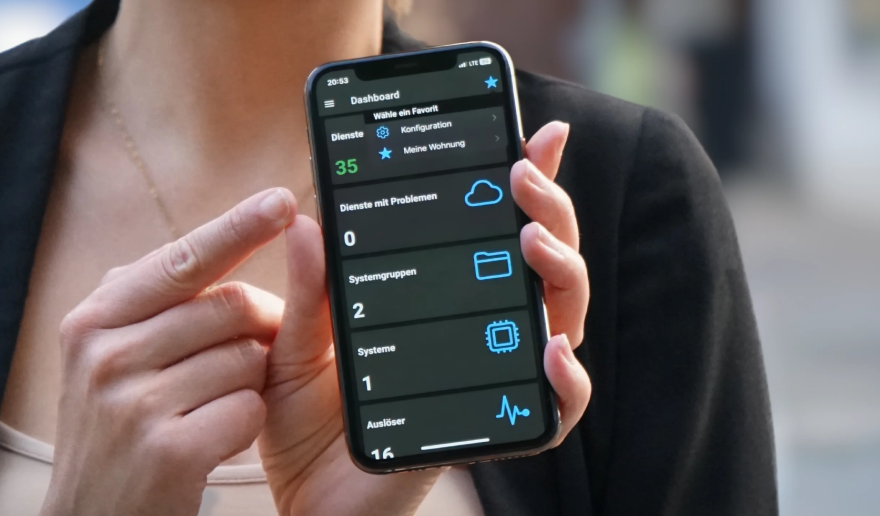Aranet — wireless IoT sensor platform. Wherever you need to measure anything – temperature, air quality, light, or any other physical parameter – Aranet’s main mission is to deliver these measurements simply, easily, and above all – wirelessly. Aranet is manufactured by SAF Tehnika — a company with over 20 years of experience in the telecom industry, microwave radio, and test & measurement equipment manufacturing, and a certified partner of Zabbix.
Contents
I. Aranet wireless sensor network (1:41)
II. Aranet in retail (5:53)
III. Indoor air quality and COVID19 (8:20)
IV. Partnership with Aranet (12:11)
V. Questions & Answers (13:52)
Aranet wireless sensor network
Aranet is a wireless sensor network consisting of the Aranet PRO base station and sensors transmitting data to one another over the 868 MHz frequency in Europe and 920 MHz frequency in the United States. This frequency allows us to have a very large line of sight distance between the sensor and the base station — up to 3 kilometers line of sight and a couple of hundred meters indoors.
Sensors are intended to measure different environmental parameters. You can connect up to a hundred sensors per base station. Sensors can be configured to send the data over different intervals — once every minute, two minutes, five, or 10 minutes. Sensors are very power efficient — with a regular AA battery, they will last up to 10 years.
Aranet ecosystem
Aranet technology is based on the LoRa physical layer. We have built our proprietary LPWAN protocol with XXTEA encryption on top of LoRa to make the radio parameters better and to increase the battery life.
Aranet technology
The brain of the system is the Aranet PRO base station – the radio receiver with a built-in web server housing SensorHUB software and internal memory for local data storage. It is made with ease of use in mind – you can connect directly to the base station with your PC, laptop, or phone over Ethernet or Wi-Fi, open up your web browser and access the free SensorHUB software. You don’t even need to install anything.
Aranet PRO base station offers a lot of features such as graphing, exporting data, etc. In addition, its internal memory allows for storing 10 years of readings even if the Internet goes down.
The sensors are sending data to the base station. Several such base stations can be agglomerated into the Aranet Cloud solution collecting data from several base stations and allowing you to access the data from anywhere.
Aranet architecture
With over 20 years of experience in radio manufacturing, we believe that we’ve created one of the best-in-class systems in terms of wireless connectivity with our base stations and in-house cloud. However, we are looking for a strategic partnership where the Aranet system can become a part of a larger system. This brought us to the partnership with Zabbix so that we can integrate our cloud solution with the Zabbix monitoring system.
Aranet philosophy
Aranet Example Use Cases
Aranet for retail
Aranet has been actively used in retail where Aranet equipment is primarily used for:
- Monitoring of freezer temperatures. Earlier, they had to check the temperature manually — somebody had to walk around with the legal pad and check the temperature to make sure that freezers are working properly and to report to the relevant government agencies. Aranet allowed for automating this process.
- Alarms in case of malfunction. In the case of a malfunction, an alarm can be sent to avoid product spoilage.
- Working on predictive maintenance, including machine learning algorithms for predictive maintenance to locate anomalies in the defrost cycle temperature data helping to prevent breakages.
Aranet in retail
Benefits
- Even the largest supermarkets (8800 m2/94 000 ft2) can be covered with a single base station.
- Manual data collection can be avoided
- Freezer temperature operating costs can be optimized (20% energy costs reduction).
- Product spoilage can be avoided.
- Litigation/fines for slip and fall accidents can be avoided.
Aranet for indoor air quality and COVID19 safety
Due to COVID19, many governments and health agencies have changed their guidelines, including the Center for Disease Control in the United States, and they now state that COVID19 can be transmitted through aerosols. Aerosols are small droplets that are released when we cough, sneeze, or talk. As these droplets are small — about five microns, they linger in the air for up to nine or more minutes. So, that means that you don’t even have to be in contact with the infected person to actually catch the disease.
This requires proper ventilation practices, which can decrease x10 the time aerosol particles stay in the air.
Aranet4 PRO – a wireless COVID19 safety network
One way to estimate if ventilation is sufficient is to measure CO2. The amount of CO2 (air exhaled by other people) in a certain room is a measure of the risk of contagion. The recommended air circulation per person is 60m3 /h, which is approximately 800ppm CO2 concentration — almost twice as much as the outside value.
Aranet wireless CO2 sensor
Aranet offers a wireless CO2 sensor that also measures temperature, relative humidity, and air pressure. It comes with a useful Bluetooth application, which allows you to easily get the latest readings. But the most important thing is that this sensor can generate alerts. So, whenever the value exceeds the critical level, you have a visual indication — green, yellow, or red, as well as an audible alert prompting to manually increase the ventilation, for instance, by opening windows.
Lately, these sensors have been gaining popularity, especially in schools, universities, and offices as they offer:
- Simple plug-and-play setup with the Aranet base station.
- Updating information available locally on each sensor, as well as centrally on the base station, so that you can see what spaces need additional ventilation.
- Free software – graphs, reports, centralized alarms.
- Control of airborne COVID19 spread in schools, offices, and other indoor facilities.
Partnership with Aranet
Aranet wireless network can be implemented in many other industries:
- Horticulture,
- Livestock,
- Building Management,
- Warehousing,
- Data Centres,
- Pharma,
- Medical,
- Retail.
So, Aranet is looking for integration and distribution partners, which are interested in wireless monitoring. Details of the partnership are available on aranet.com or can be requested from [email protected].
The Aranet’s core value is the wisdom of Lord Kelvin: “you can only improve what you can measure”. So, we strive for delivering these measurements in the easiest and the most straightforward way possible so that you could improve whatever you wish.
Questions & Answers
Question. Is there some way or some benefit to integrating Aranet with Zabbix?
Answer. Aranet has many and diverse applications, as well as Zabbix. So, adding physical parameters on top of the monitoring solution network parameters would help out. For data centers or retail stores, in addition to alerts of something wrong with the network, alarms of something physical happening would be useful. It might be useful to be alerted, for instance, if it’s too hot.
Question. Is it possible to switch your sensors to LoRaWAN so that we can use existing networks?
Answer. We have decided to have our proprietary network based on the LoRa physical layer with proprietary communication software. This decision was made for several reasons:
- ease of use— the main thing that our customers actually value. Aranet system can be easily set up in a couple of minutes — you just lay the sensors and they start working. With LoRaWAN you have the base station from one provider, and sensors from the other, so it takes time to make the system work. Aranet works out of the box.
- improved battery due to our protocol.
- improved security as with Aranet you control the whole ecosystem from the base station to sensors. In addition, with Aranet you won’t face dependencies, password management, or communication issues.
- private network.
Question. Are there any electrical sensors — volts, amps, power, or anything like that?
Answer. We can monitor voltage, but these are mostly for third-party integrations. We have pulse output sensors, which you can connect to these electricity meters, for instance. So, this can be monitored.














 Prev Post
Prev Post 




